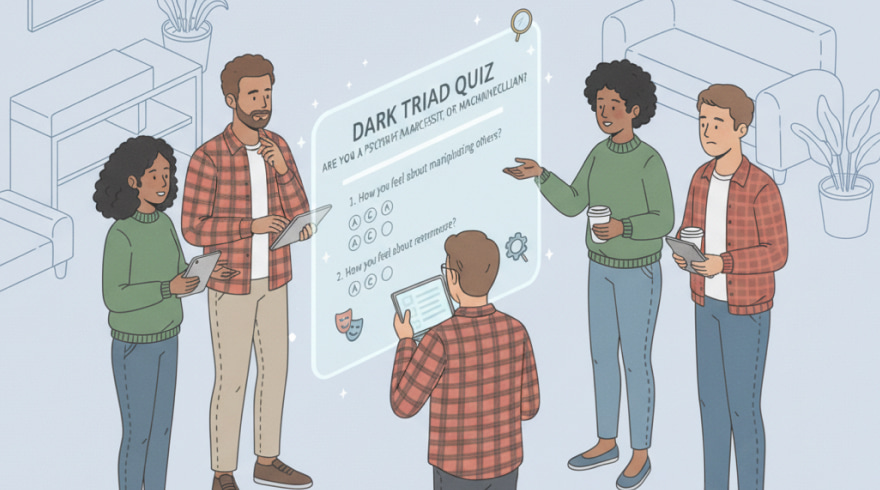A Complete Guide to Understanding the Dark Triad Quiz
- 7 November 2025

What the Dark Triad Measures and Why People Seek Assessments
The term “Dark Triad” refers to three interrelated personality constructs: Machiavellianism, narcissism, and subclinical psychopathy. Although popular culture sometimes turns these topics into sensational soundbites, the underlying research explores stable patterns in manipulation, entitlement, and callousness. Taken responsibly, a self-assessment can offer structured reflection on tendencies that influence relationships, leadership, negotiation, and ethical decision-making. It is not a diagnosis, nor a moral verdict; rather, it is a snapshot of dispositional leanings relative to common norms.
Among the many tools that circulate online, the dark triad quiz is often the entry point because it translates complex constructs into digestible questions and an approachable score summary. People turn to these assessments to understand how certain motives might sway their choices under stress, competition, or social pressure. They also want language that helps them identify risk factors for conflict, especially in high-stakes environments like startups, sales, and politics where persuasion is prized. When interpreted with care, the insights can prompt calmer self-regulation and more intentional behavior.
- Machiavellianism: strategic calculation, cynicism about others’ motives, ends-over-means decision frames.
- Narcissism: grandiosity, status sensitivity, admiration seeking, and fragile self-esteem beneath a confident veneer.
- Psychopathy (subclinical): low empathy, impulsivity, sensation seeking, and muted remorse when harming others.
Critically, these dimensions exist on continua. Most people hover around moderate scores that can be channeled productively in certain contexts, while extremes increase interpersonal hazards. That nuance matters for any fair interpretation and practical use.
Science, Validity, and Ethical Use of Dark Triad Measures
Sound assessments are built on psychometrics: careful item design, factor analysis, and validation against behavioral markers. Reliability (e.g., internal consistency and test–retest stability) ensures a measure captures the same construct over time, while validity (construct, convergent, and predictive) confirms it aligns with theory and forecasts real outcomes. Public-facing instruments typically distill longer research scales into briefer versions, which improves accessibility but can dilute precision. Understanding that trade-off helps set expectations and prevents overconfidence in single scores.
In practice, a responsible dark triad personality quiz will disclose its source items or lineage, report reliability estimates, and provide norms derived from large, diverse samples. Look for transparent scoring rubrics, percentile explanations, and cautionary notes about context, faking-good, and social desirability bias. Because impression management can suppress sensitive admissions, better tools use wording that reduces demand characteristics and includes validity checks. Ethical guidelines also emphasize confidentiality, consent, and the avoidance of stigmatizing labels that foreclose growth or paint people into static categories.
Researchers caution against deterministic thinking. High scores do not doom someone to harmful actions, just as low scores do not guarantee prosocial behavior. Motivations interact with values, skills, incentives, and culture. Longitudinal outcomes change when feedback, coaching, and environmental design nudge healthier habits, which is why interpretations belong within a larger framework of development rather than a standalone verdict.
Interpreting Results and Converting Insight Into Benefits
Meaningful interpretation starts with percentiles rather than raw totals, because placement within a norm group clarifies whether a score is relatively typical or uncommon. It helps to read trait profiles in combination: a person can be high in strategic calculation yet low in impulsivity, producing a different pattern than someone who is thrill-seeking but not particularly scheming. Context also matters: what shows up under deadline pressure might recede when incentives reward cooperation and transparency.
For many readers, the dark personality quiz becomes a springboard for targeted self-improvement plans. Leaders can translate insights into concrete guardrails, structured decision protocols to counter shortcuts, external feedback to temper ego, and friction-reducing rituals that lower the odds of reactive choices. Couples and teams can establish boundaries, clarify expectations around honesty, and pre-commit to processes that mitigate manipulation. Over time, these micro-interventions compound into better trust, smoother negotiation, and fewer costly conflicts.
- Use the profile to identify “hot zones” such as high-stakes negotiations or competitive hiring loops.
- Pair the findings with complementary strengths like empathy training, perspective-taking, and accountability.
- Revisit scores periodically to monitor change after coaching or environment tweaks.
Above all, treat the output as hypotheses to test with real behavior. Journaling, 360 feedback, and observable metrics turn abstract labels into practical experiments that either confirm or refine your understanding.
Tools, Formats, and Choosing the Right Measure
Short forms, while convenient, trade granularity for speed; longer batteries reveal more specific facets at the cost of time. Response formats vary from 5-point Likert items to forced-choice statements that curb acquiescence bias. Good instruments share clear instructions, non-leading wording, and accessible explanations that demystify scoring. If you are comparing options, focus on psychometric transparency, normative data breadth, and whether the instrument provides actionable suggestions rather than vague labels or fear-based framing.
For users who want a quick screen before a deeper dive, the dark traits quiz can serve as a triage step that flags areas worth exploring with more robust scales. Below is a concise comparison to help you weigh speed, depth, and use case when selecting an assessment path that fits your goals and attention budget.
| Instrument | Items | Scale Type | Typical Duration | Primary Focus | Best For |
|---|---|---|---|---|---|
| Short Dark Triad (SD3) | 27 | 5-point Likert | 6–8 minutes | Balanced coverage of three traits | General users seeking reliable breadth |
| Dirty Dozen | 12 | 7-point Likert | 3–4 minutes | Rapid screening | Quick check with minimal friction |
| LSRP (Levenson SRP) | 26 | 4-point Likert | 7–9 minutes | Primary/secondary psychopathy | Deeper look at impulsivity/callousness |
| NPI (Narcissistic Personality Inventory) | 40 | Forced-choice | 10–15 minutes | Narcissism facets | Detailed status/vanity dynamics |
Whatever you choose, note that no tool predicts behavior with certainty. The most valuable outputs are specific behavioral suggestions, not merely labels. Seek instruments that connect scores to situational strategies, like pre-commitment rules for hiring, standardized negotiation checklists, and routines that reward prosocial wins rather than short-term maneuvers.
Practical Tips for Taking an Assessment and Using the Results
Preparation shapes quality. Choose a quiet setting, avoid rushing, and answer according to typical behavior rather than aspirational self-image. If a statement feels ambiguous, interpret it as it would play out across most weeks, not exceptional days. After finishing, write a short reflection about scenarios where each trait either helped or hindered you; that anchors abstractions in concrete memories you can revisit later. Share selectively with a trusted peer to gain an outside view that calibrates blind spots.
When you are ready to experiment, the dark quiz should be followed by a simple action plan that translates insights into habits. For instance, if scores suggest a tendency toward instrumental politeness, build a checklist that asks, “Did I seek mutual benefit?” before major decisions. If impulsivity spikes under stress, pre-schedule cool-down intervals or require a second opinion for irreversible choices. Over a month, measure outcomes like conflict frequency, teammate satisfaction, and decision reversals to see whether your interventions are working.
- Pair your results with values clarification to ensure tactics align with long-term identity.
- Use reminders, calendar nudges or physical prompts, to keep guardrails top of mind.
- Reassess quarterly to observe trends and prevent complacency.
Treat the entire process as iterative design. Small, evidence-based tweaks compound, making self-mastery less about willpower and more about systems that reliably produce better choices.
FAQ: Common Questions About Dark Triad Assessments
Are these assessments diagnostic tools?
No. They are non-clinical instruments intended for education and self-reflection. Clinical diagnosis requires professional evaluation and different criteria than those used in popular personality measures.
Can scores change over time?
Yes. While core dispositions are relatively stable, sustained environmental changes, coaching, and deliberate practice can shift patterns and behaviors linked to the underlying traits.
How accurate are short forms compared to longer scales?
Short forms are efficient but sacrifice nuance and sometimes reliability. Longer scales typically provide better facet coverage and more robust psychometrics, though they require more time and focus.
Is it possible to game the answers?
People can attempt impression management, but well-designed instruments use wording and scoring strategies to reduce that effect. Answering honestly yields more useful insights for personal development.
Should I share my results with others?
Share selectively and with context. Provide your reflections, not just numbers, and invite respectful feedback. Avoid environments where results could be used punitively or without informed understanding.
Latest News
-
![Comprehensive Guide to Sociopathy Self-Assessments and Quizzes]()
- 10 November, 2025
-
![The Guide to Narcissism Self-Assessments: Insights, Benefits, and Smart Next Steps]()
- 6 November, 2025
-
![Your Complete Guide to Assessing Dark Triad Traits Online]()
- 5 November, 2025



